Submitted by Anju George
A Call to Urbanists around Canada to Revive Canada’s Main Streets
Canada Architecture News - Sep 12, 2020 - 14:43 5668 views
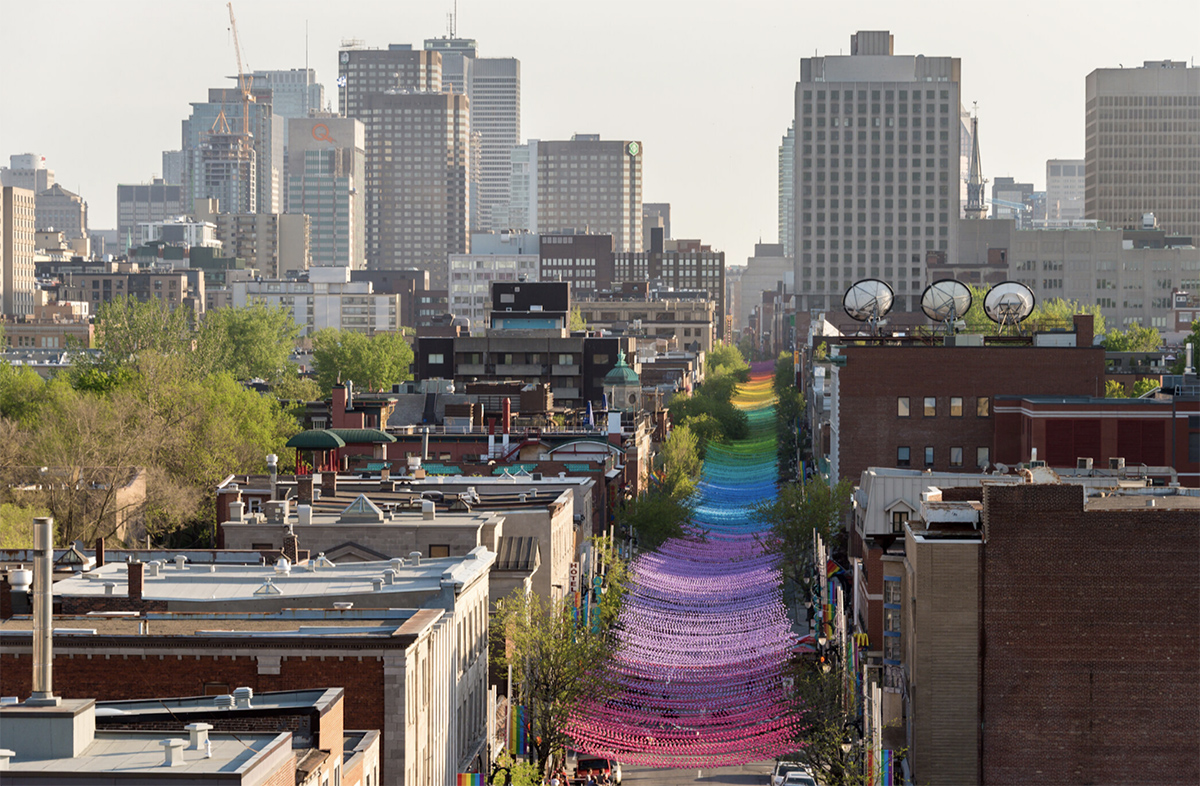
The Main Streets Design Challenge, a competition held by the Canadian Urban Institute (CUI) in collaboration with the Royal Architectural Institute of Canada (RAIC), has partnered with a network of supporting partners like the Council for Canadian Urbanism (CanU) and the Canadian Institute of Planners (CIP), to roll out a brilliant strategy to envision the future of Canada’s Main Streets.
The Canadian Urban Institute is the national platform where learning, sharing and collaborating in Canadian city building happens. Through research, engagement and storytelling, CUI’s mission is to ensure Canada builds vibrant, equitable, livable and resilient cities1. The RAIC is the leading voice for excellence in the built environment in Canada, demonstrating how design enhances the quality of life, while addressing important issues of society through responsible architecture2.
Before we dive right into what the Challenge is all about, let us first understand what Main Streets truly characterize.
Cities in Canada contain a multitude of Main Streets that are integral to the city’s growth and progress. In actuality, these community gathering spaces, which can range from libraries to parks, theatres to squares, and faith institutions to laneways, also house residences situated above retail stores, and do often border residential neighbourhoods. Main Streets are the lifelines of cities in terms of being engines of prosperity, and centres of cultural and social well-being. These streets are pockets that bustle with commercial activity along a street or a district and comprise an assortment of small and independently owned businesses. They convey different meanings to different people. On the down side, Main Streets have been going through a lot in terms of powerful macro- and micro-economic shifts. The businesses that have been thriving on a number of these streets are being left behind. In fact, so many of our Main Streets have an immense amount of untapped potential waiting to be realized.
As Janet Yellen once quipped, “Although we work through financial markets, our goal is to help Main Street, not Wall Street.”
As part of the Main Streets Design Challenge, the CUI has joined hands with the RAIC to invite all Canadians passionate about pioneering placemaking and design solutions that will engender the resiliency of Canada’s main streets to submit ideas for the challenge. This Challenge stems from the Bring Back Main Street initiative, a nationally co-ordinated research and action campaign launched by CUI, to ensure a watertight recovery post-pandemic.
Participants are being given the opportunity to develop avant-garde, tenable and resilient design solutions for Canadian Main Streets, that can be administered both during the recovery and post-pandemic. Students, professionals and academics in the realm of design are welcome to share their contributions. Fresh graduates, current students, artists, business improvement organizations, developers and technologists, are also invited to showcase their design ideas and perspectives. In fact, submissions by teams with members from diverse backgrounds are especially encouraged.
The Competition is expected to draw participants from all corners of Canada. The timeline of the Challenge is listed below. An online portal is welcoming submissions for the same. All submissions that meet the project guidelines will be published on CUI’s online platform on a rolling basis in a Main Street Design Playbook that will hopefully motivate organizations, municipalities and individuals to act. The Playbook will be released in entirety on World Architecture Day that falls on the 5th of October, 2020.
Cycle 1 deadline: Passed
Cycle 2 deadline: Passed
Cycle 3 deadline: September 18, 2020
Playbook full release: October 5, 2020 (World Architecture Day)
A jury from the CUI and RAIC will be pressured to make the toughest of choices selecting a few projects that have the potential to be taken forward. With the pandemic at large, the penchant for creativity is of the essence.
The submissions should be uploaded by visiting the link below:
To garner more information on the submission requirements, please visit the link below to the ‘Main Streets Design Challenge’ document, https://bringbackmainstreet.ca/s/MainSt_CallForEntries_200706.pdf.
Among the more captivating submissions are the ones submitted by the three alumni of Ryerson University (who graduated with a Bachelors of Urban Planning in 2019) and the City of Mississauga.
I chose to speak with members of both teams to get their perspectives on the Challenge and understand what they aimed to accomplish by positioning their projects in the real world.
OPEN: Alumni of Ryerson University
John Homsy and Lisa Mishko and Morgan Dundas joined me over a Zoom call to discuss their compelling proposal.
I asked them to provide me with an overarching perspective on what their project would ultimately bring to the table and what it was likely to strive to achieve in a post-pandemic world.
John was quick to quip that they wanted to essentially achieve increased accessibility to workspaces by installing the avante-garde concept, OPEN, that stands for Outdoor, Productivity, Eco, Nodes. With the current situation owing to the pandemic, a lot of downtown cores are only at 10% capacity now. Many individuals working from home have a lot on their plate, from managing children and coping with stress, to dealing with limited accessibility to resources and interruption to essential services. This project seeks to provide these individuals with an alternate, yet healthier working plan, which allows them to engage with the natural world while meeting their targets at work. The benefits are indeed numerous. As Dr. Edward O. Wilson once quoted, “Nature holds the key to our aesthetic, intellectual, cognitive and even spiritual satisfaction.”
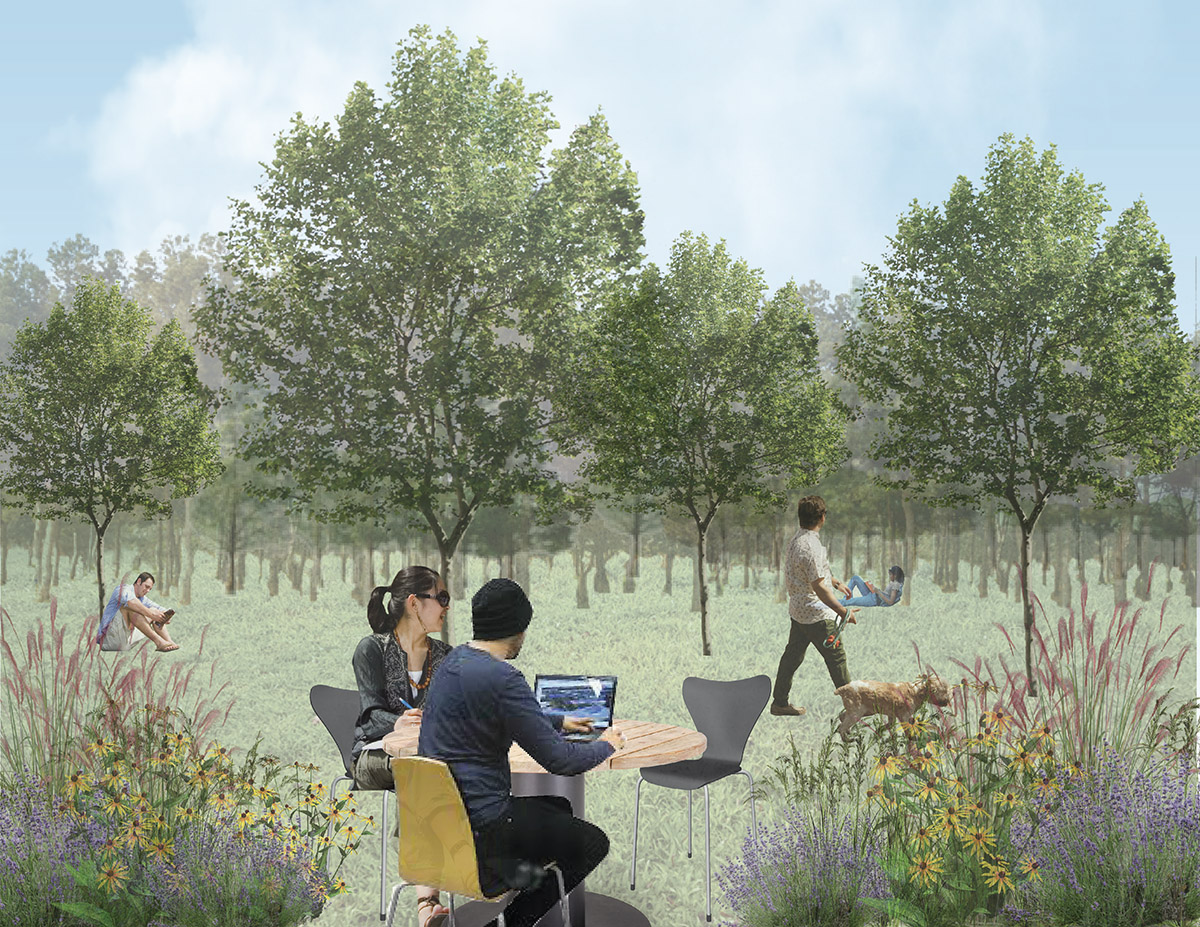
Workspaces adapting to different environments. Image © Ryerson University.
This proposal stands out primarily because of the nature of its workspaces to adapt and respond to different environments. On the one hand, an open field with its native vegetation intact can consist of desks (with workstations) placed spatially apart. On the other hand, a shipping container can be repurposed as a conference room that can house a small group of people.
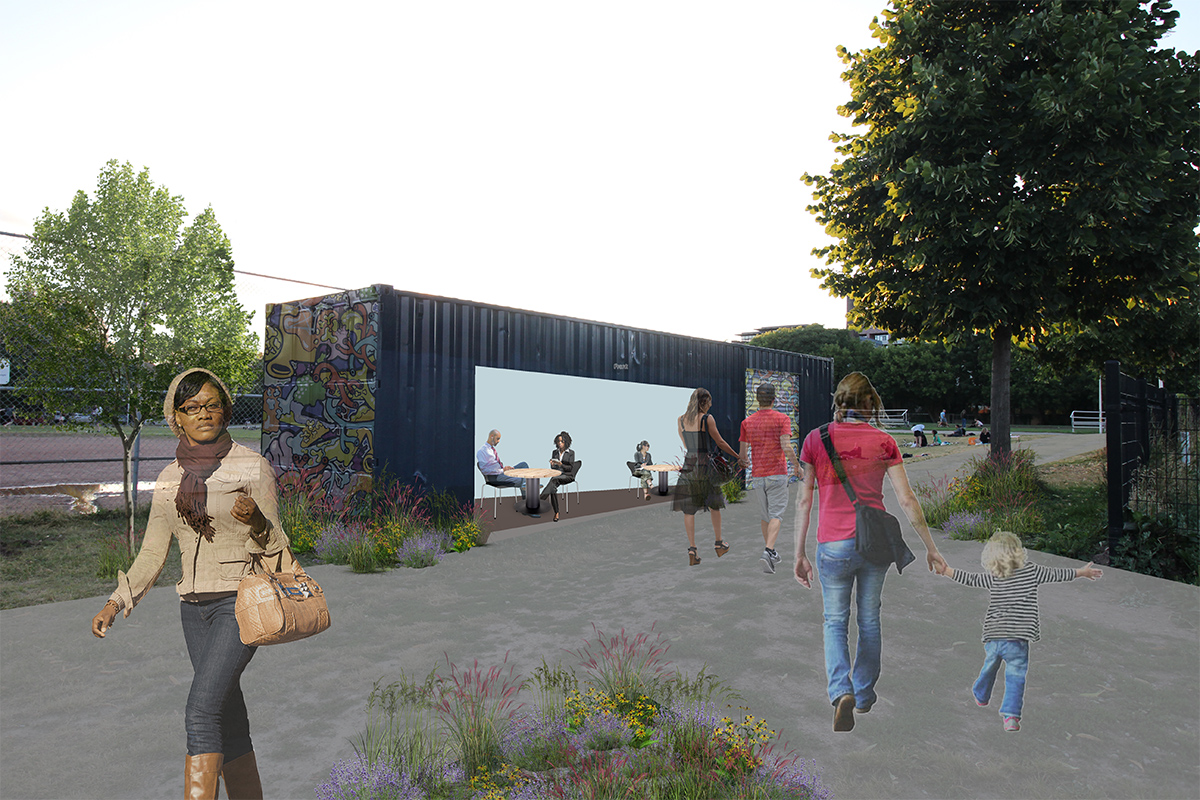
Sorauren Park (Large Scale: Shipping Container). Image © Ryerson University.
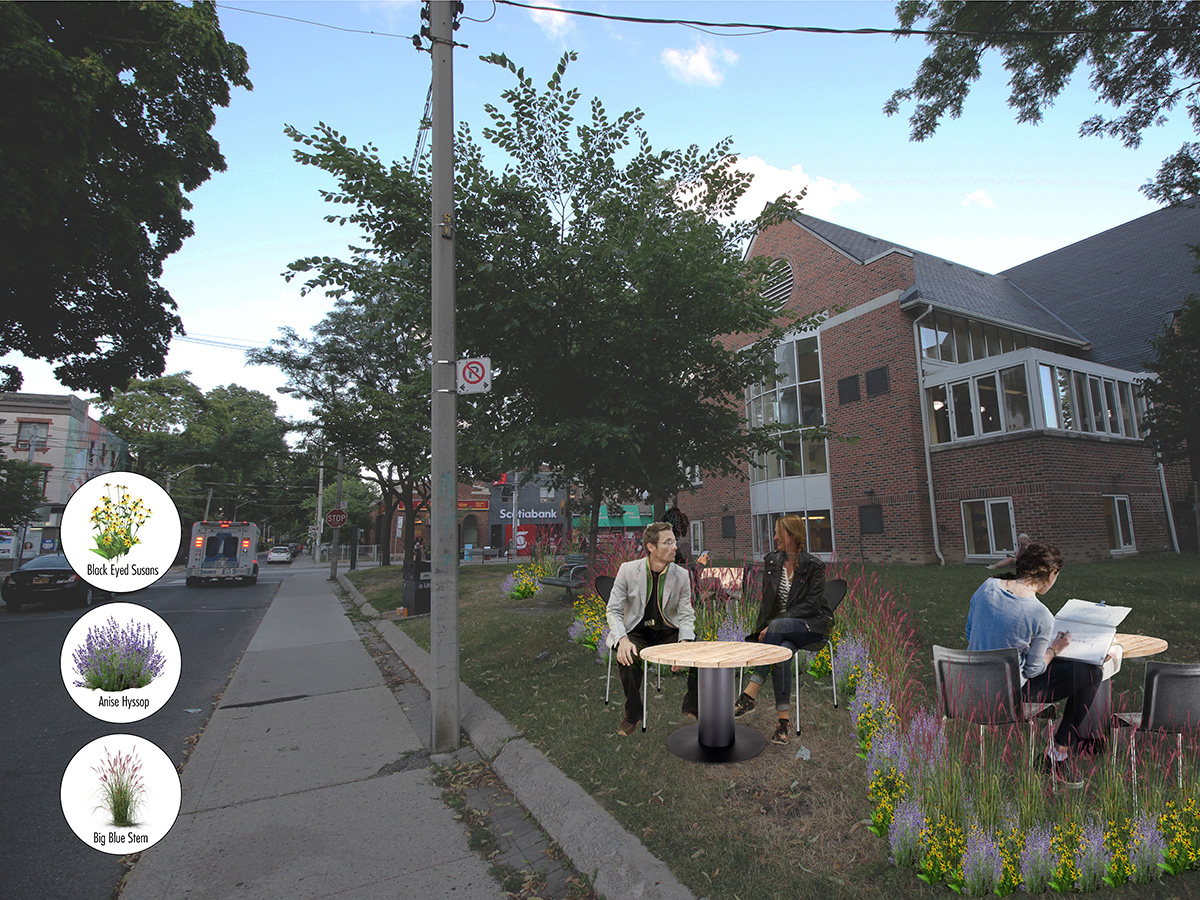
High Park Library (Medium Scale: Urban Park). Image © Ryerson University.
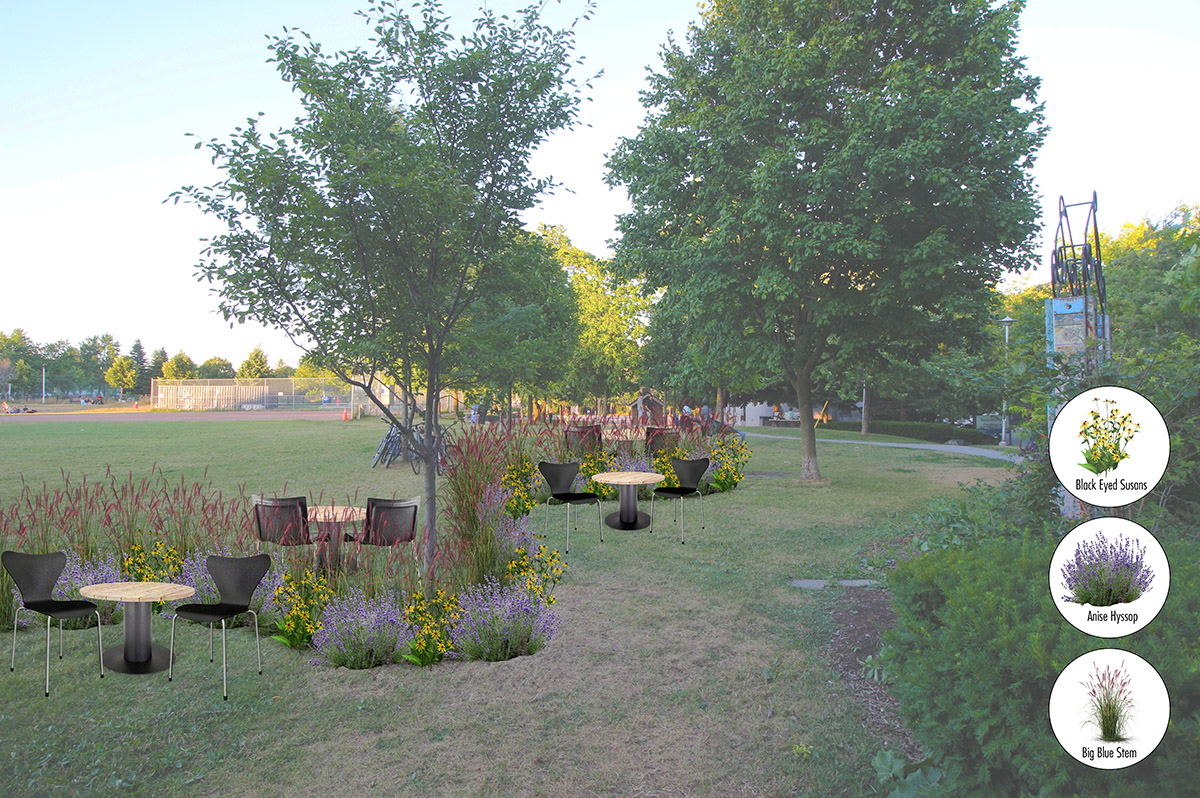
Sorauren Park (Medium Scale: Urban Park). Image © Ryerson University.
I also asked them whether some sort of permitting would be a necessity at some point in time. Lisa said that urban gardens were a workable proposition if local community members came together to actually build and create these urban gardens. A community who is invested and can meaningfully contribute is bound to take care of the premises more than a city official generally would. Planting days would hopefully get people safely together and reduce stress levels. John advocated for connecting with Residents Associations and schools with community garden initiatives. Morgan suggested reaching out to Business Improvement Areas (BIAs) as a probable solution and partnering with CafeTO on a smaller-scale, that would give rise to extended patios that are publicly operated and are relatively easy to maintain.
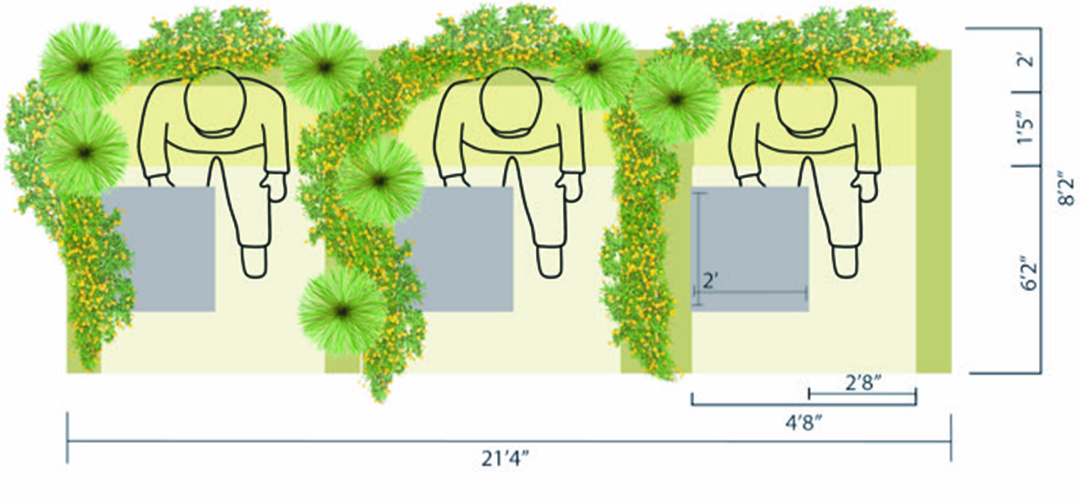
Plan View (Small Scale: Parking Space). Image © Alumni, Ryerson University.
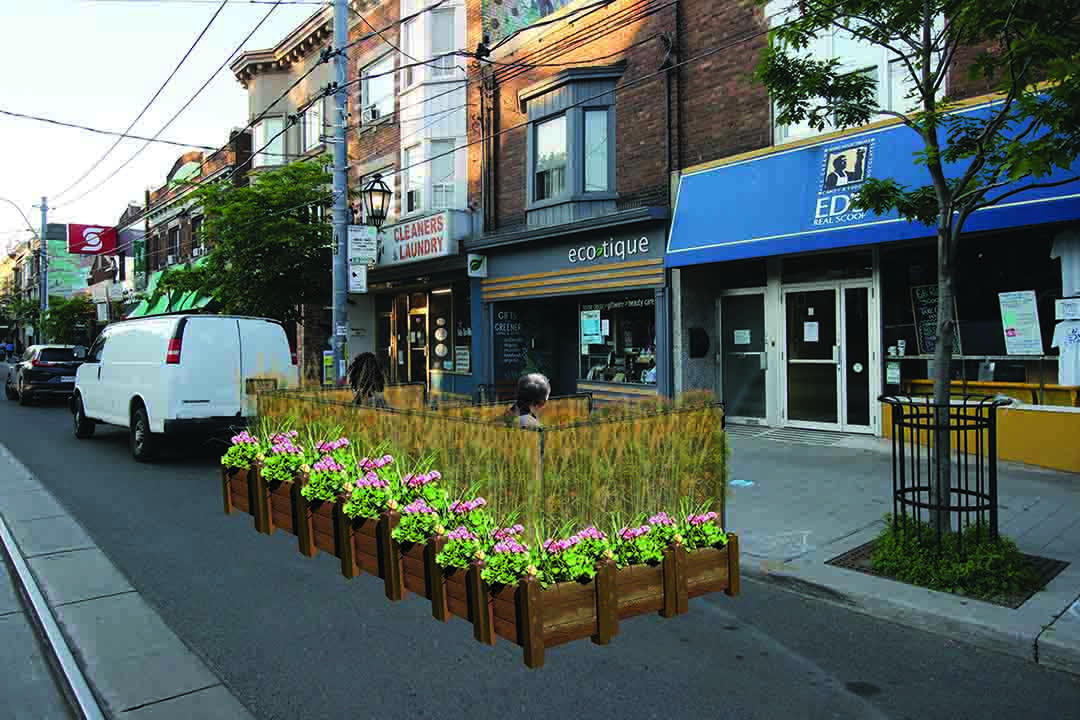
Concept Rendering (Small Scale: Parking Space). Image © Alumni, Ryerson University.
All in all, this project aspires to furnish diverse social opportunities in close proximity, thereby bringing about healthy and prosperous work environs.

Impacts on Intervention of Movement through types of Streetscapes. Image © Alumni, Ryerson University.
For more details on the project, please visit their submission on CUI’s platform, https://bringbackmainstreet.ca/msdc-submissions/outdoor-productivity-eco-nodes.
Living Arts Drive Tactical Urbanism Project: City of Mississauga
The Manager of the Urban Design Section in the Planning and Building Department, Sharon Mittmann, kicked off the virtual meeting by introducing the Living Arts Drive Tactical Urbanism project and eloquently articulated why it matters so much at a time like this.
The design of sustainable and safe environments is especially crucial in punishing times like these. The City of Mississauga’s proposal is designed to adapt to the ‘new normal’ in terms of how Complete Streets should become equitable and accessible for all. The focus of this proposal is to bring to light the creation of a healthy urban environment by encouraging social interaction and cultural exchange that drive the activities of urban spaces.
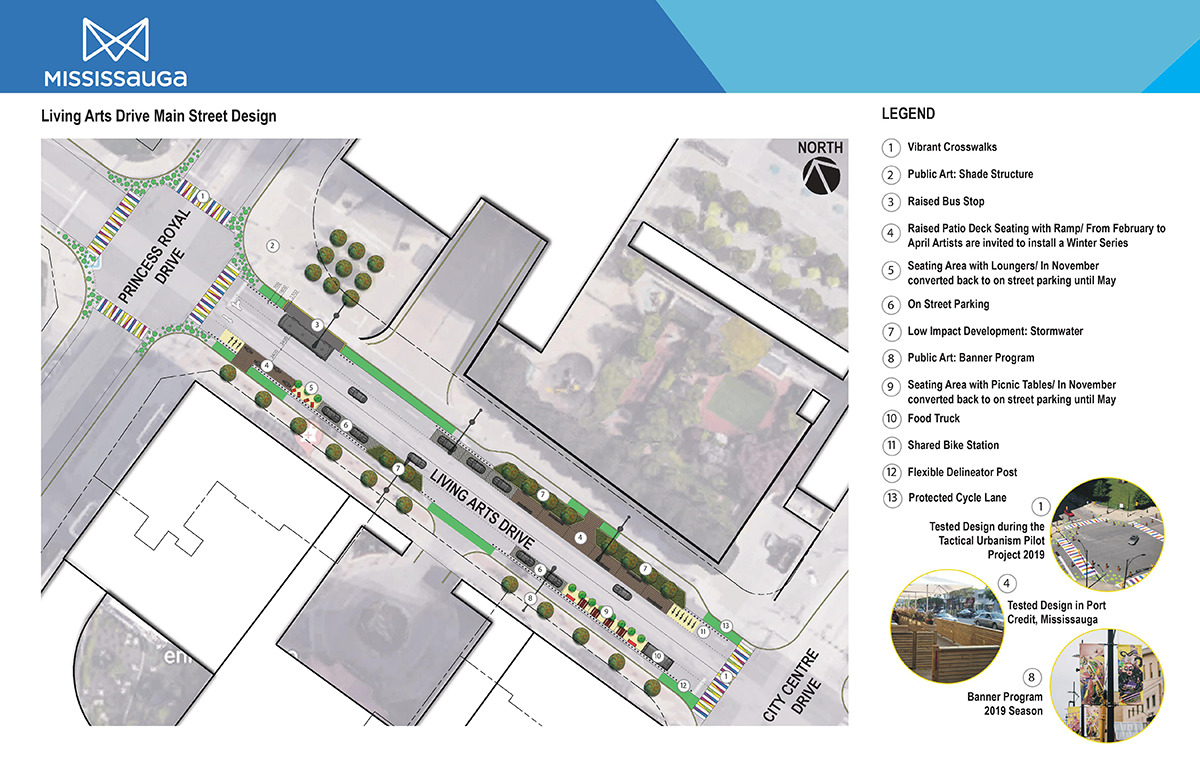
Main Street Design Layout. Image © City of Mississauga.
With the support of Council, Mississauga’s Downtown Public Realm Strategy team, headed by Strategic Leader, Sue Ann Laking, was behind the launching of the Living Arts Drive Tactical Urbanism Pilot Project. The selected site was strategically situated adjacent to residential and retail units, and made for an ideal area for the Pilot to be executed. By implementing the Pilot with its various design components, the City was able to ascertain the attitudes and public thinking towards a Complete Street. Sharon stated that business owners were also happy with the proposal.
The Commissioner of the Planning and Building Department, Andrew Whittemore, was very vocal in discerning the value that this proposal attributes to education and how that translates to learning opportunities that are sometimes at odds with the existing urban ideologies in place. “The significance of providing meaningful space outdoors cannot be emphasized enough,” he said. The project should allow people from all walks of life to garner varied experiences on what the project means to them. This Urbanism Project has the capacity to foster constructive change by highlighting the power of the public realm.
One of the organizers of this design, Jacqueline Viscardi, a Landscape Architectural Researcher with the City, mentioned the main idea of the project was to provide a comfort level for all users by making the amenities accessible, which in essence become an extension of compact urban living spaces. By drawing attention to a user-friendly public realm, this proposal aims to transform the existing not so pleasant street views into a more vibrant Complete Street. Another fascinating element of this proposal is the way that these Main Streets can modify their behaviour depending on the urgency at hand.
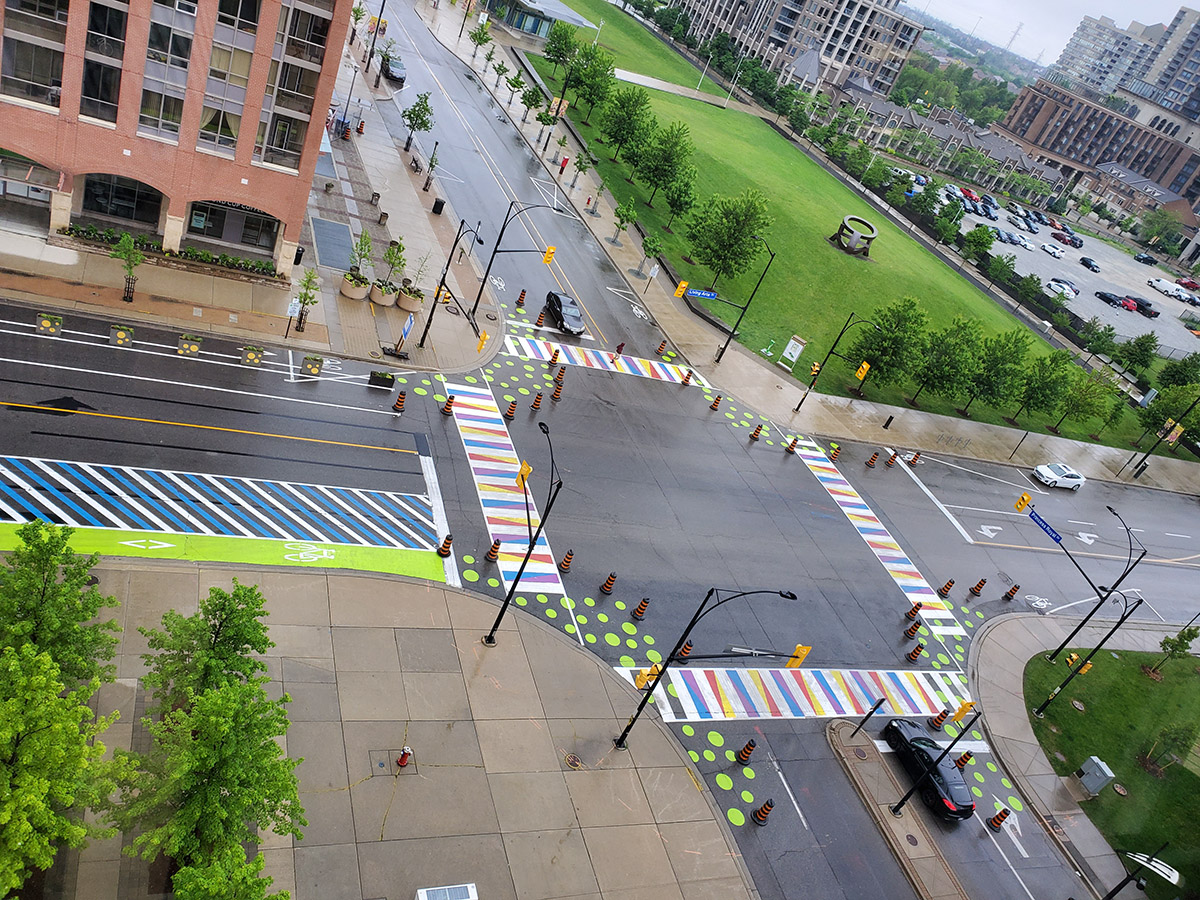
Vibrant Crosswalks. Image © City of Mississauga.
Jacqueline also spoke about the streetscape strategy adopted. The design showcases a Low Impact Development (LID) feature, a reduction of vehicular lanes to allow for a protected cycle lane, enhanced planting, and introduces spaces that can be converted into art pop-ups through the cooler seasons.
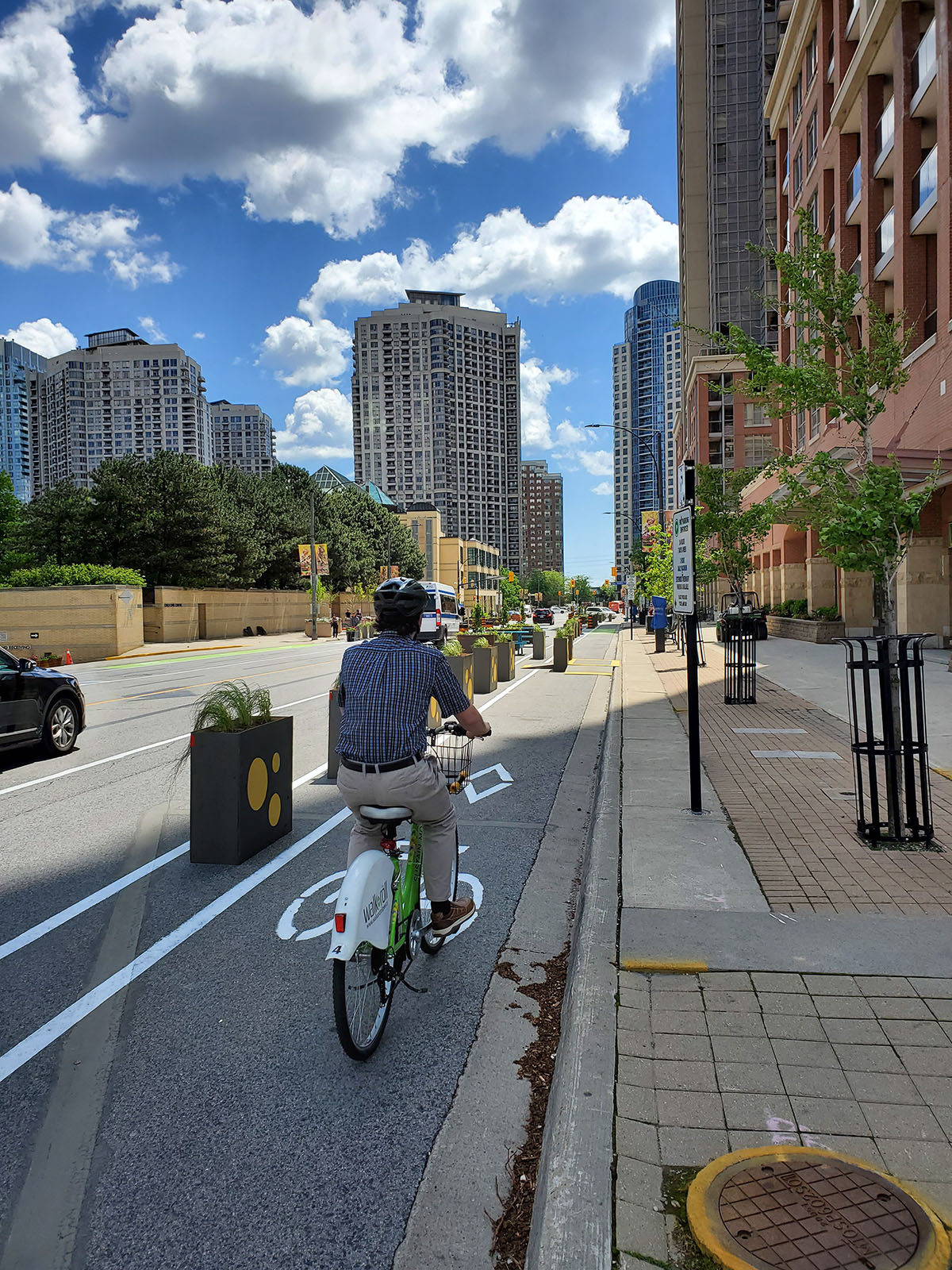
Protected Cycle Lane. Image © City of Mississauga.
I asked them the burning question that is relevant under the circumstances that all of us now are very much a part of.
“Since we are living in a post-pandemic world and may continue to be doing so for a couple of years to come, would there be any health and safety regulations put in place for people frequenting the public realm, as in the mandatory usage of masks, physical distancing, etc.?”
Sharon asserted that COVID-19 concerns were taken into account while preparing the design proposal. The built environment needs gathering spaces that become an extension of the public realm and, can therefore; provide more room to physically distance. Owing to the pandemic, undue importance has also been given to the design and width of sidewalks (1.2 to 1.5 metres), and the design of the public realm (5.75 metres).
This design worked wonders for a lot of people because it not only provided the public a place to enjoy, but also inspired and encouraged other departments at the City of Mississauga to explore the countless benefits that a Complete Street can offer. Complete Streets are meant to afford safe and comfortable access for all users including those with disabilities. Safe and innovative design should not be an afterthought, but an integral planning feature to planning streetscape environments.
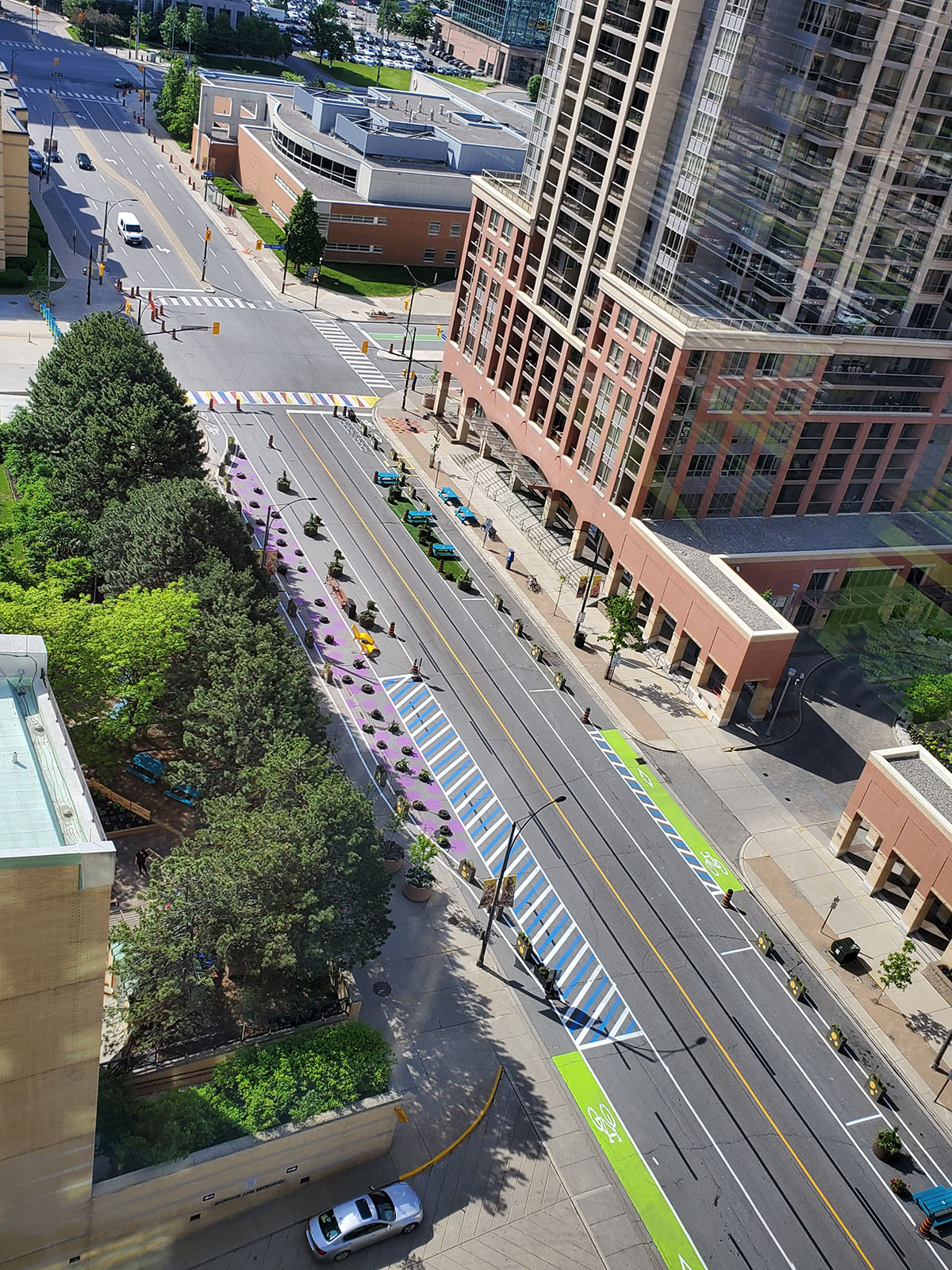
Street Design. Image © City of Mississauga.
As someone once said, "A street is a spatial entity and not the residue between buildings." This is exactly the emotion that the City of Mississauga is trying to evoke with their gripping design proposal.
To gather more information about the project, please visit their submission on CUI’s platform, https://bringbackmainstreet.ca/msdc-submissions/living-arts-drive-tactical-urbanism-project.
References:
2: https://raic.org/raic/about-raic
Top Cover Image: Canadian Urban Institute’s Main Streets Design Challenge
